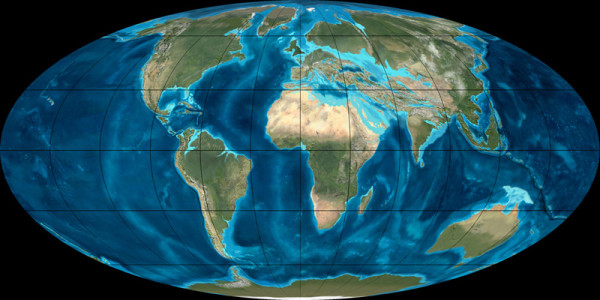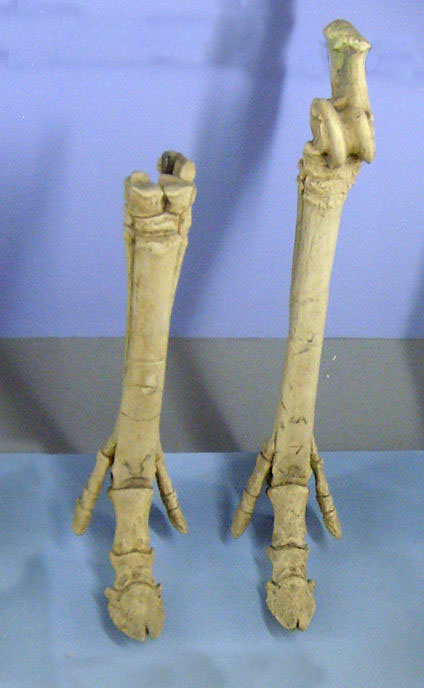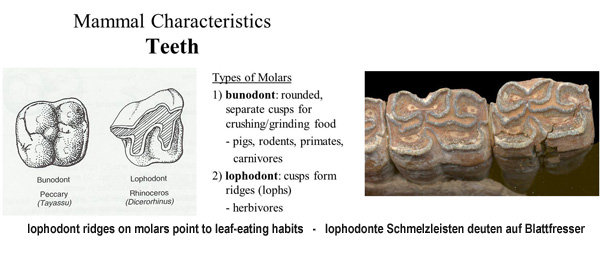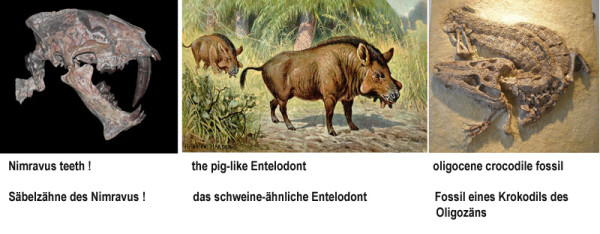History of the Horse – Part 5
|
|
Geschichte des Pferdes – Teil 5
|
- In the last 4 Blogs we saw that the development of the very first horse-like animals on our planet began 56 million years ago, in an era called the “Eocene”.
- Up to here we have accompanied our primeval horses through their first 22 million years. Many things happened! Climate change made development possible, but also triggered many necessary adaptations – to new surroundings, new food and so on – and who ever could not adapt quickly enough risked dying out again. At the end of the Eocene all the European side-lines of primeval horses were extinct!
The Oligocene:
- The next period, which we are entering now, is called the Oligocene – which started 33.9 million years ago and lasted 10.9 million years (to about 23 million years ago). If we believe that scientists grouped eras according to the significant changes in the development of the species, then we can perhaps assume that things move twice as fast now – the Oligocene is only half the length of the Eocene.
|
|
- In den letzten vier Blogs sahen wir, daß die Entwicklung der ersten Urahnen des Pferdes auf unserem Planeten vor 56 Millionen Jahren in einer Zeit, Eozän genannt, begann.
- Bisher haben wir unsere Urpferde durch ihre ersten 22 Millionen Jahre hinweg begleitet. Viel ist schon passiert! Klimawandel machte diese Entwicklungen möglich, löste aber auch viele nötige Anpassungen aus – an neue Landschaften, anderes Futter usw.- und wer sich nicht schnell genug anpassen konnte, riskierte wieder auszusterben. Am Ende des Eozäns waren alle europäischen Seitenlinien der Urpferde wieder verschwunden.
Das Oligozän:
- Die nächste Periode, in die wir nun eintreten, heißt Oligozän – welches vor 33,9 Millionen Jahren begann und 10,9 Millionen Jahre andauerte (bis etwa vor 23 Mio Jahren). Wenn wir annehmen, daß die Wissenschaftler diese Perioden nach bedeutenden Veränderungen in der Entwicklung der Arten benennen, dann heißt das vielleicht, daß jetzt alles doppelt so schnell geht – das Oligozän ist nur halb so lang wie das Eozän.
|
|
Climate change:
- In the Oligocene the temperature sank about by 5 degrees C worldwide. In some parts of the Antarctic there again appeared some great glaciers (for the first time in about 200 million years), the formation of which lead to a sinking of the sea level of about 30 meters. This means that new land bridges materialized. Later during the course of the Oligocene the climate became even colder and more ice formed – the sea level dropped up to 150 meters. The cause seems to be that South America separated completely from the Antarctic and a strong circular polar current became possible, which cooled the waters significantly. A similar thing happened in the North, where Norway broke away from Greenland.
- Another change resulting from the sinking sea level was an emergence of new land along the coasts and the drying out of large areas – to steppes and even large deserts.
|
|
Klimawandel:
- Im Oligozän sank die Temperatur weltweit um etwa 5 Grad C. In einigen Teilen der Antarktik formten sich große Gletscher (zum ersten Mal seit etwa 200 Millionen Jahren), was zu einer Absenkung des Meeresspiegels um etwa 30 Meter führte. Das bedeutete, daß neue Landverbindungen zu Tage traten. Im weiteren Lauf des Oligozän wurde das Klima noch kälter und mehr Eisfelder entstanden – der Meeresspiegel sank bis zu 150 Meter ab. Die Ursache dafür scheint die vollständige Trennung Südamerikas von der Antarktis gewesen zu sein, was einen starken Zirkumpolarstrom ermöglichte, der die Wassertemperatur erheblich abkühlte. Ähnliches passierte im Norden, wo Norwegen von Grönland wegbrach.
- Eine weitere Auswirkung der Absenkung des Meeresspiegels war die Entstehung von Neuland an den Küsten und die Ausbreitung von Trockengebieten – von Steppen bis zu richtigen Wüsten.
|
 Shape of the World in the Oligocene – South America separates from the Antarctic, Norway breaks away from Greenland.
Die Welt im Oligozän – Südamerika trennt sich von der Antarktis, Norwegen bricht von Grönland weg. |
- I must admit that I cannot see those described geological changes clearly in the provided pictures – the world of the Eocene (Blog 01) and the one shown above are still quite similar to my eyes (there too South America looks already separated from the Antarctic, which shouldn’t be so). Especially the emergence of land-bridges, which made the migration of species possible from one continent to another, is not evident.
So: primeval horses extinct in Europe – but in North America they keep trotting!
- The last kind we saw was the Hyracotherium, which however seems to have died out about 5 million years into the oligocene.
- Another species, during the transition between the Eocene and the Oligocene, was the Mesohippus (“middle horse”), which stems from a different subfamily, the Anchitheriinae (another extinct part of the”un-even-toed” Perissodactyla) .
- The Mesohippus first appeared during the middle Eocene and thrived until the late Miocene (which ended about 11 million years ago). Slightly different from the Mesohippus was the next genus to appear – the Miohippus!
A misnomer should not confuse us:
- The main group of horses living in the Oligocene are called Miohippus. According to the Florida Museum of Natural History, the natural scientist Othniel Charles Marsh first believed Miohippus to have lived during the Miocene (which is the next period after the Oligocene) and thus named the genus using this incorrect conclusion. More recent research provides evidence that Miohippus actually lived during the Oligocene.
Miohippus – in North America!
- These horses lived in areas as wide as from Alberta in Canada to California and Florida. At this point they are three-toed (and remain so for the next several million years), with the middle toe bearing most of the weight.
|
|
- Ich muß zugeben, daß ich die beschriebenen geologischen Veränderungen nicht klar in den gezeigten Bildern erkennen kann – die Welt des Eozäns (im Blog 01) verglichen mit dem oben sehen mir noch recht ähnlich aus (auch da sieht Südamerika schon von der Antarktis getrennt aus, was nicht sein dürfte). Vor allem erkenne ich keine Landbrücken, welche eine Wanderung der Arten von einem Kontinent zum anderen ermöglichte.
Also: Urpferde in Europa ausgestorben – aber in Nordamerika gehts weiter!
- Die letzte Art, die wir betrachteten, war das Hyracotherium, welches aber etwa 5 Millionen Jahre ins Oligozän hinein dann ausgestorben zu sein scheint.
- Eine weitere Gattung während der Übergangszeit vom Eozän ins Oligozän war das Mesohippus (das „mittlere Pferd“), welches aus einer anderen Unterfamilie, den Anchitheriinae (einer dann ebenfalls ausgestorbenen Unterart der Unpaarhufer) abstammt.
- Das Mesohippus tauchte zuerst im mittleren Eozän auf und gedieh bis ins späte Miozän (das etwa vor 11 Millionen Jahren endete). Leicht unterschiedlich vom Mesohippus war die nächste Gattung, die erschien – das Miohippus!
Eine falsche Benennung soll uns nicht verwirren:
- Die Urpferde dieser Periode werden Miohippus genannt. Nach dem Naturkundemuseum in Florida soll der Naturkundler Othniel Charles Marsh zuerst angenommen haben, daß das Miohippus im Miozän lebte (der nächsten Periode nach dem Oligozän), und daher diese Gattung so benannt hat. Neuere Forschung beweist, daß Miohippus schon im Oligozän vorhanden war.
Miohippus also – in Nordamerika!
- Diese Urpferde lebten in Gegenden verbreitet von Alberta in Kanada bis nach Kalifornien und Florida. Zu diesem Zeitpunkt (und für einige weitere Millionen Jahre) haben Alle drei Zehen, von dem der mittlere das meiste Gewicht trug.
|
 In the Oligocene the Perissodactyls still walked on three toes, the middle one bearing most of the weight.
Im Oligozän liefen die Unpaarhufer noch auf drei Zehen, von denen der mittlere das meiste Gewicht trug.
|
- Many kinds of artiodactyls (with an even number of toes) and perissodactyls (with an uneven number of toes such as our horses) developed during this period. There were about 18 different kinds of the Miohippus (“Small Horse”) alone.
Their teeth:
- The teeth of the miohippus show that they now adapt to the food in relatively dry steppes. Climate change has a way of suddenly taking away the fruity stuff they were used to having for breakfast – what can one do!
- They now had to be mainly leaf eaters (and when those disappear during developing winter seasons later on, they have to adapt again!). Although their teeth were still brachyodont , which means “low-crowned” and flat, they now showed slightly raised and obliquely positioned “lophodont” ridges in the tooth enamel, which indicate a change to an increasing leaf content in their menu. The content of tooth cement (the harder stuff) increased.
|
|
- Viele Gattungen der Paarhufer und Unpaarhufer entwickelten sich in dieser Zeit. Es gab allein etwa 18 verschiedene Arten des Miohippus („kleines Pferd“).
Ihre Zähne:
- Die Zähne des Miohippus zeigen, daß sie sich nun dem Futter der Trockensteppe anpaßten. Der Klimawandel bringt es so mit sich, daß das schöne Obst, an welches man zum Frühstück gewohnt war, auf einmal verschwindet – was kann man machen!
- Wir wissen, sie waren nun hauptsächlich Blattfresser (und als die Blätter mit den sich entwickelnden Jahreszeiten im Winter verschwinden, müssen sie sich wiederum anpassen!). Ihre Zähne waren zwar immer noch niederkronig, zeigten aber nun deutlich erhöhte quergestellte Schmelzleisten („lophodont“), die einen verstärkten Wechsel zu blattreicher Pflanzenkost anzeigen. Der Anteil des Zahnzements (das harte Zeug) stieg an.
|
 The Miohippus still had relatively flat, low molars, but lophodont ridges developed, which point to leaf-eating habits.
Das Miohippus hatte zwar noch relativ niederkronige Backenzähne, aber nun mit lophodonten Schmelzleisten, die auf Blattfresser deuten. |
- Also, unlike earlier horses, the row of teeth now contained a single gap behind the front teeth (where the bit now rests in the modern horse. But nobody tells me why – as I think it unlikely that the natural development already anticipated the inventions of later dressage riders!)
What were the dangers for our primeval horses at that time?
- Next to the climate changes it was mainly the drying out of the Turgai-Street, a new land connection, where was before a shallow sea between Europe and Asia. Via this new path several newcomers arrived in Europe, among them were rhinos and ruminants and the first pig-like animals, the Entelodonts, whose heads alone measured up to a meter! It is possible that all that changed the fauna and diminished the habitat of the primeval horses sufficiently to hasten their extinction. The predators of the time were also not to be sneezed at: cat-like Nimravids with enormous tusks, and crocodiles still existed.
|
|
- Im Unterschied zu den früheren Urpferden gibt es nun in der Zahnreihe auch eine Lücke (wo beim heutigen Reitpferd das Gebiß liegt. Hier sagt mir aber keiner warum – denn es ist ja nicht anzunehmen, daß die natürliche Entwicklung schon die Erfindungen der späteren Reiter vorausgesehen hat!)
Was und wer waren die damaligen Gefahren für unsere Urpferde?
- Neben den klimatischen Veränderungen war es hauptsächlich die nun verlandende „Turgai-Straße“, eine neue Landverbindung, wo vorher ein Flachmeer zwischen Europa und Asien bestand. Über diese wanderten viele neue Arten nach Europa ein, riesige Nashörner und Wiederkäuer und ein schweine-ähnliches Entelodont, deren Kopf allein bis zu einem Meter lang sein konnte! All diese haben wohl die Fauna und das generelle Habitat der Urpferde genügend verändert, um ihr Aussterben zu beschleunigen. Auch die Raubtiere dieser Zeit waren nicht zu verachten: Nimraviden waren katzenähnliche Räuber mit gewaltigen Säbelzähnen, und es gab auch immer noch Krokodile.
|
 New species wandered into Europe via the land connection of the dried out Turgai Street. They may have hastened the extinction of the primeval horses along with the climate change in those parts.
Neue Arten erschienen in Europa über die ausgetrocknete Turgai Straße. Diese könnten neben dem Klimawandel auch das Aussterben der Urpferde in diesen Regionen beschleunigt haben. |
- In North America, where the horse genus did not die out, there were similar predators and in addition several kinds of dogs. But there the Miohippus survived into the early Miocene – the next period (from about 23 million years to 5.3 million years ago), which we will get to in the next Blog!
Read on !!
|
|
- In Nordamerika, wo die Urpferde ja nicht ausstarben, gab es ähnliche Raubtiere und vor allem mehrere Unterfamilien der Hunde. Aber das Miohippus überdauerte bis ins frühe Miozän – die nächste Periode (von ca. 23 Millionen Jahren bis 5.3 Millionen Jahren), die im nächsten Blog an die Reihe kommt!
Lesen Sie weiter!!
|